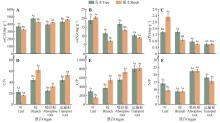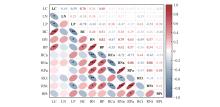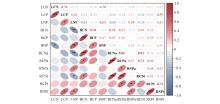Bulletin of Botanical Research ›› 2025, Vol. 45 ›› Issue (5): 795-806.doi: 10.7525/j.issn.1673-5102.2025.05.013
• Original Paper • Previous Articles Next Articles
Xinyu YANG1, Shuo ZHANG1, Xiwen ZHANG1, Qingshan ZHENG2, Rilige SU3, Jiacun GU1( )
)
Received:2025-03-04
Online:2025-09-20
Published:2025-09-28
Contact:
Jiacun GU
E-mail:gjcnefu@163.com
CLC Number:
Xinyu YANG, Shuo ZHANG, Xiwen ZHANG, Qingshan ZHENG, Rilige SU, Jiacun GU. Ecological Stoichiometric Characteristics of Leaves, Branches, and Fine Roots of Typical Trees and Shrubs in Baiyinaobao National Nature Reserve[J]. Bulletin of Botanical Research, 2025, 45(5): 795-806.
Table 1
Characteristics of sampling plots in three terrain types of the Baiyinaobao National Nature Reserve
地形 Terrain | 纬度 Latitude /(°) | 经度 Longitude /(°) | 海拔 Elevation /m | 坡度 Gradient /(°) | 土壤含水率 Soil water content/% | 土壤pH Soil pH | ω | ||
|---|---|---|---|---|---|---|---|---|---|
土壤全碳 Soil total carbon /(mg·g-1) | 土壤全氮 Soil total nitrogen /(mg·g-1) | 土壤全磷 Soil total phosphorus /(mg·g-1) | |||||||
阳坡 Sunny slope | 43.53 | 117.19 | 1 363.00 | 24.67 | 10.14±0.85b | 6.57±0.20a | 46.29±7.54b | 3.77±0.38b | 0.38±0.04a |
阴坡 Shade slope | 43.53 | 117.20 | 1 352.00 | 19.50 | 24.24±3.82b | 6.51±0.25a | 68.23±7.44ab | 5.52±0.60ab | 0.50±0.05a |
平地 Flat | 43.52 | 117.21 | 1 331.00 | 0 | 49.17±10.40a | 6.02±0.23a | 90.56±18.04a | 6.97±1.22a | 0.45±0.07a |
Table 3
Two-way ANOVA of the effects of life form and organ on plant C,N, and P stoichiometric characteristics
指标 Index | 生活型 Life form | 器官 Organ | 生活型×器官 Life form×Organ | ||||||
|---|---|---|---|---|---|---|---|---|---|
| df | F | P | df | F | P | df | F | P | |
| C | 1 | 2.74 | 0.100 | 3 | 79.60 | <0.001 | 3 | 15.97 | <0.001 |
| N | 1 | 8.15 | 0.006 | 3 | 56.05 | <0.001 | 3 | 3.79 | 0.010 |
| P | 1 | 1.41 | 0.240 | 3 | 71.74 | <0.001 | 3 | 22.16 | <0.001 |
| C/N | 1 | 14.97 | <0.001 | 3 | 73.88 | <0.001 | 3 | 7.40 | <0.001 |
| C/P | 1 | 3.01 | 0.090 | 3 | 62.97 | <0.001 | 3 | 5.50 | 0.002 |
| N/P | 1 | 6.51 | 0.010 | 3 | 86.11 | <0.001 | 3 | 3.01 | 0.040 |

Fig.2
Mass fraction of C,N,and P(A-C) and stoichiometric characteristic ratios(D-F) in leaves, branches, absorptive roots and transport roots of trees and shrubs in Baiyinaobao National Nature ReserveDifferent capital letters indicated significant differences between life forms(P<0.05), different lowercase letters indicated significant differences among organs(P<0.05).


Fig.3
Correlations among C,N,and P contents in the leaves,branches,absorptive roots and transport rootsLC. Leaf C content; LN. Leaf N content; LP. Leaf P content; BC. Branch C content; BN. Branch N content; BP. Branch P content; RCa. Absorptive root C content; RNa. Absorptive root N content; RPa. Absorptive root P content; RCt. Transport root C content; RNt. Transport root N content; RPt. Transport root P content. *.P<0.05; **.P<0.01; ***.P<0.001.


Fig.4
Correlations among C,N,and P stoichiometric ratios of the leaves,branches,absorptive roots and transport rootsLCN. Leaf C/N ratio; LCP. Leaf C/P ratio; LNP. Leaf N/P ratio; BCN. Branch C/N ratio; BCP. Branch C/P ratio; BNP. Branch N/P ratio; RCNa. Absorptive root C/N ratio; RCPa. Absorptive root C/P ratio; RNPa. Absorptive root N/P ratio; RCNt. Transport root C/N ratio; RCPt. Transport root C/P ratio; RNPt. Transport root N/P ratio. *.P<0.05; **.P<0.01; ***.P<0.001.

| [1] | ELSER J J, STERNER R W, GOROKHOVA E,et al.Biological stoichiometry from genes to ecosystems[J].Ecology Letters,2000,3(6):540-550. |
| [2] | 王绍强,于贵瑞.生态系统碳氮磷元素的生态化学计量学特征[J].生态学报,2008,28(8):3937-3947. |
| WANG S Q, YU G R.Ecological stoichiometry characteristics of ecosystem carbon,nitrogen and phosphorus elements[J].Acta Ecologica Sinica,2008,28(8):3937-3947. | |
| [3] | AERTS R, CHAPIN F S.The mineral nutrition of wild plants revisited:a re-evaluation of processes and patterns[J].Advances in Ecological Research,1999,30:1-67. |
| [4] | ELSER J J, BRACKEN M E S, CLELAND E E,et al.Global analysis of nitrogen and phosphorus limitation of primary producers in freshwater,marine and terrestrial ecosystems[J].Ecology Letters,2007,10(12):1135-1142. |
| [5] | STERNER R W, ELSER J J.Ecological stoichiometry:the biology of elements from molecules to the biosphere[M].Princeton,NJ∶Princeton University Press,2002. |
| [6] | GÜSEWELL S. N∶P ratios in terrestrial plants:variation and functional significance[J].New Phytologist,2004,164(2):243-266. |
| [7] | 宁志英,李玉霖,杨红玲,等.科尔沁沙地主要植物细根和叶片碳、氮、磷化学计量特征[J].植物生态学报,2017,41(10):1069-1080. |
| NING Z Y, LI Y L, YANG H L,et al.Carbon,nitrogen and phosphorus stoichiometry in leaves and fine roots of dominant plants in Horqin Sandy Land[J].Chinese Journal of Plant Ecology,2017,41(10):1069-1080. | |
| [8] | 陈壹铭,单立山,马静,等.西北干旱区荒漠植物叶片和细根碳、氮、磷化学计量特征[J].生态学报,2024,44(9):3648-3659. |
| CHEN Y M, SHAN L S, MA J,et al.Carbon,nitrogen and phosphorus stoichiometry in leaves and fine roots of desert plants in arid region of northwest China[J].Acta Ecologica Sinica,2024,44(9):3648-3659. | |
| [9] | 朱亮,顾国军,徐振锋,等.北亚热带常绿阔叶林乔灌草物种的碳氮磷生态化学计量比[J].应用与环境生物学报,2019,25(6):1277-1285. |
| ZHU L, GU G J, XU Z F,et al.Ecological stoichiometric ratio of carbon,nitrogen,and phosphorus in tree,shrub,and herb species in a subtropical evergreen broad-leaved forest[J].Chinese Journal of Applied and Environmental Biology,2019,25(6):1277-1285. | |
| [10] | 俞月凤,韦建华,胡钧铭,等.桂西北喀斯特地区退化群落灌草不同器官N、P生态化学计量内稳性特征[J].生态学报,2024,44(12):5367-5376. |
| YU Y F, WEI J H, HU J M,et al.Nitrogen and phosphorus stoichiometric homoeostasis in different organs of shrubs and herbs in degraded vegetation communities in the karst area of northwestern Guangxi[J].Acta Ecologica Sinica,2024,44(12):5367-5376. | |
| [11] | LUO Y, PENG Q W, LI K H,et al.Patterns of nitrogen and phosphorus stoichiometry among leaf,stem and root of desert plants and responses to climate and soil factors in Xinjiang,China[J].Catena,2021,199:105100. |
| [12] | PREGITZER K S, DEFOREST J L, BURTON A J,et al.Fine root architecture of nine North American trees[J].Ecological Monographs,2002,72(2):293-309. |
| [13] | LI A, GUO D L, WANG Z Q,et al.Nitrogen and phosphorus allocation in leaves,twigs,and fine roots across 49 temperate,subtropical and tropical tree species:a hierarchical pattern[J].Functional Ecology,2010,24(1):224-232. |
| [14] | MCCORMACK M L, DICKIE I A, EISSENSTAT D M,et al.Redefining fine roots improves understanding of below-ground contributions to terrestrial biosphere processes[J].New Phytologist,2015,207(3):505-518. |
| [15] | 刘逸潇,王传宽,上官虹玉,等.兴安落叶松不同径级根碳氮磷钾化学计量特征的种源差异[J].应用生态学报,2023,34(7):1797-1805. |
| LIU Y X, WANG C K, SHANGGUAN H Y,et al.Provenance variation of root C,N,P,and K stoichiometric characteristics under different diameter classes of Larix gmelinii [J].Chinese Journal of Applied Ecology,2023,34(7):1797-1805. | |
| [16] | 高润宏,丛林,周效明,等.中国沙地云杉[M].北京:中国林业出版社,2016. |
| GAO R H, CONG L, ZHOU X M,et al. Picea mongolica in China[M].Beijing:China Forestry Publishing House,2016. | |
| [17] | 刘鑫,宋立宁,张金鑫,等.沙地云杉液流周向和径向变异及其对蒸腾耗水估算的影响[J].应用生态学报,2024,35(9):2483-2491. |
| LIU X, SONG L N, ZHANG J X,et al.Azimuthal and radial variations in sap flow and its effects on the estimation of transpiration for Picea mongolica [J].Chinese Journal of Applied Ecology,2024,35(9):2483-2491. | |
| [18] | 陈塔娜.不同群落类型的沙地云杉林天然更新特征[D].呼和浩特:内蒙古农业大学,2020. |
| CHEN T N.Natural regeneration characteristics of Picea mongolica forest with different community types[D].Hohhot:Inner Mongolia Agricultural University,2020. | |
| [19] | 黄三祥,罗菊春,赵秀海.沙地云杉林天然更新格局及其影响因子的灰关联分析[J].林业资源管理,2009(5):64-68. |
| HUANG S X, LUO J C, ZHAO X H.Natural regeneration pattern and grey relevancy analysis of influencing factors of Picea mongolica forest in Inner Mongolia[J].Forest Resources Management,2009(5):64-68. | |
| [20] | TANG Z Y, XU W T, ZHOU G Y,et al.Patterns of plant carbon,nitrogen,and phosphorus concentration in relation to productivity in China’s terrestrial ecosystems[J].Proceedings of the National Academy of Sciences of the United States of America,2018,115(16):4033-4038. |
| [21] | 张珂,何明珠,李新荣,等.阿拉善荒漠典型植物叶片碳、氮、磷化学计量特征[J].生态学报,2014,34(22):6538-6547. |
| ZHANG K, HE M Z, LI X R,et al.Foliar carbon,nitrogen and phosphorus stoichiometry of typical desert plants across the Alashan Desert[J].Acta Ecologica Sinica,2014,34(22):6538-6547. | |
| [22] | 王飞,刘世增,康才周,等.干旱胁迫对沙地云杉光合、叶绿素荧光特性的影响[J].干旱区资源与环境,2017,31(1):142-147. |
| WANG F, LIU S Z, KANG C Z,et al.Effects of drought stress on photosynthesis and chlorophyll fluorescence characteristics of Picea mongolica [J].Journal of Arid Land Resources and Environment,2017,31(1):142-147. | |
| [23] | DING L, LU Z F, GAO L M,et al.Is nitrogen a key determinant of water transport and photosynthesis in higher plants upon drought stress?[J].Frontiers in Plant Science,2018,9:1143. |
| [24] | XING S P, CHENG X Q, KANG F F,et al.The patterns of N/P/K stoichiometry in the Quercus wutaishanica community among different life forms and organs and their responses to environmental factors in northern China[J].Ecological Indicators,2022,137:108783. |
| [25] | WANG Z Q, HUANG H, YAO B Q,et al.Divergent scaling of fine-root nitrogen and phosphorus in different root diameters,orders and functional categories:a meta-analysis[J].Forest Ecology and Management,2021,495:119384. |
| [26] | DING J X, GE W J, LIU Q,et al.Temperature drives the coordination between above-ground nutrient conservation and below-ground nutrient acquisition in alpine coniferous forests[J].Functional Ecology,2023,37(6):1674-1687. |
| [27] | CHAVE J, COOMES D, JANSEN S,et al.Towards a worldwide wood economics spectrum[J].Ecology Letters,2009,12(4):351-366. |
| [28] | FORTUNEL C, FINE P V A, BARALOTO C.Leaf,stem and root tissue strategies across 758 neotropical tree species[J].Functional Ecology,2012,26(5):1153-1161. |
| [29] | XING K X, ZHAO M F, NIINEMETS Ü,et al.Relationships between leaf carbon and macronutrients across woody species and forest ecosystems highlight how carbon is allocated to leaf structural function[J].Frontiers in Plant Science,2021,12:674932. |
| [30] | 周永姣,王满堂,王钊颖,等.亚热带59个常绿与落叶树种不同根序细根养分及化学计量特征[J].生态学报,2020,40(14):4975-4984. |
| ZHOU Y J, WANG M T, WANG Z Y,et al.Nutrient and ecological stoichiometry of different root order fine roots of 59 evergreen and deciduous tree species in subtropical zone[J].Acta Ecologica Sinica,2020,40(14):4975-4984. | |
| [31] | GUO Y P, YAN Z B, GHEYRET G,et al.The community-level scaling relationship between leaf nitrogen and phosphorus changes with plant growth,climate and nutrient limitation[J].Journal of Ecology,2020,108(4):1276-1286. |
| [32] | 贺合亮,阳小成,李丹丹,等.青藏高原东部窄叶鲜卑花碳、氮、磷化学计量特征[J].植物生态学报,2017,41(1):126-135. |
| HE H L, YANG X C, LI D D,et al.Stoichiometric characteristics of carbon,nitrogen and phosphorus of Sibiraea angustata shrub on the eastern Qinghai-Xizang Plateau[J].Chinese Journal of Plant Ecology,2017,41(1):126-135. | |
| [33] | VANCE C P, UHDE-STONE C, ALLAN D L.Phosphorus acquisition and use:critical adaptations by plants for securing a nonrenewable resource[J].New Phytologist,2003,157(3):423-447. |
| [34] | LI H L, CRABBE M J C, XU F L,et al.Seasonal variations in carbon,nitrogen and phosphorus concentrations and C∶N∶P stoichiometry in different organs of a Larix principis-rupprechtii Mayr.plantation in the Qinling Mountains,China[J].PLoS One,2017,12(9):e0185163. |
| [35] | HASAN M M, HASAN M M, SILVA J A T DA,et al.Regulation of phosphorus uptake and utilization:transitioning from current knowledge to practical strategies[J].Cellular & Molecular Biology Letters,2016,21:7. |
| [36] | 陈佳瑞,王国梁,孟敏,等.干旱胁迫对3种灌木不同器官化学计量特征的影响[J].应用生态学报,2021,32(1):73-81. |
| CHEN J R, WANG G L, MENG M,et al.Effects of drought stress on the stoichiometric characteristics in different organs of three shrub species[J].Chinese Journal of Applied Ecology,2021,32(1):73-81. | |
| [37] | MAKINO W, COTNER J B, STERNER R W,et al.Are bacteria more like plants or animals? Growth rate and resource dependence of bacterial C∶N∶P stoichiometry[J].Functional Ecology,2003,17(1):121-130. |
| [38] | KOERSELMAN W, MEULEMAN A F M.The vegetation N:P ratio:a new tool to detect the nature of nutrient limitation[J].Journal of Applied Ecology,1996,33(6):1441-1450. |
| [39] | 原雅楠,李正才,王斌,等.不同林龄榧树根、枝、叶的C、N、P化学计量及内稳性特征[J].南京林业大学学报(自然科学版),2021,45(6):135-142. |
| YUAN Y N, LI Z C, WANG B,et al.Ecological stoichiometry in leaves,branches and roots of Torreya grandis with different forest ages and its stoichiometric homoeostasis[J].Journal of Nanjing Forestry University (Natural Sciences Edition),2021,45(6):135-142. | |
| [40] | VERMA A, NAOREM A, KEERTHIKA A,et al.Biomass and carbon partitioning across different components of agroforestry systems in the arid zones of India[J].Agroforestry Systems,2024,98:3089-3108. |
| [41] | TIAN S H, LIU X, JIN B C,et al.Contribution of fine roots to soil organic carbon accumulation in different desert communities in the Sangong River Basin[J].International Journal of Environmental Research and Public Health,2022,19(17):10936. |
| [42] | COBLE A P, CAVALERI M A.Light acclimation optimizes leaf functional traits despite height-related constraints in a canopy shading experiment[J].Oecologia,2015,177:1131-1143. |
| [43] | RÜGER N, WIRTH C, WRIGHT S J,et al.Functional traits explain light and size response of growth rates in tropical tree species[J].Ecology,2012,93(12):2626-2636. |
| [44] | MATHUR S, JAIN L, JAJOO A.Photosynthetic efficiency in sun and shade plants[J].Photosynthetica,2018,56:354-365. |
| [45] | PANG Y, TIAN J, ZHAO X,et al.The linkages of plant,litter and soil C∶N∶P stoichiometry and nutrient stock in different secondary mixed forest types in the Qinling Mountains,China[J].PeerJ,2020,8:e9274. |
| [46] | 吴鹏,崔迎春,赵文君,等.茂兰喀斯特区68种典型植物叶片化学计量特征[J].生态学报,2020,40(14):5063-5080. |
| WU P, CUI Y C, ZHAO W J,et al.Leaf stoichiometric characteristics of 68 typical plant species in Maolan National Nature Reserve,Guizhou,China[J].Acta Ecologica Sinica,2020,40(14):5063-5080. | |
| [47] | HOULTON B Z, WANG Y P, VITOUSEK P M,et al.A unifying framework for dinitrogen fixation in the terrestrial biosphere[J].Nature,2008,454:327-330. |
| [48] | 王瑞禛,罗丽莹,孙嘉伟,等.会同成熟杉木器官C∶N∶P生态化学计量的动态特征[J].中南林业科技大学学报,2020,40(4):64-71. |
| WANG R Z, LUO L Y, SUN J W,et al.Seasonal dynamics of leaf,branch and root C∶N∶P ecological stoichiometry of mature Cunninghamia lanceolata in Huitong[J].Journal of Central South University of Forestry & Technology,2020,40(4):64-71. | |
| [49] | DING D D, ARIF M, LIU M H,et al.Plant-soil interactions and C∶N∶P stoichiometric homeostasis of plant organs in riparian plantation[J].Frontiers in Plant Science,2022,13:979023. |
| [1] | Lei GAO, Ruitong YANG, Baodong LIU, Shuxia JIA, Yafen GUO, Xiaoyang CUI. Diversification of Plant Soil Nitrogen Uptake Strategies and Its Ecological Implications [J]. Bulletin of Botanical Research, 2025, 45(5): 662-674. |
| [2] | Qize ZHAO, Xiaofei CHA, Shaojie ZHENG, Yuanyou WANG, Xinglan WEI, Qiong DONG. Response of Stoichiometric Characteristics of C, N and P and Biomass of Fraxinus malacophylla Seedlings to Rainfall Changes [J]. Bulletin of Botanical Research, 2025, 45(5): 695-706. |
| [3] | Wenhui YAN, Shilong DUAN, Lin ZHANG. Mechanisms and Regulation of Interactions between AM Fungi and Hyphosphere Bacteria in Organic Phosphorus Mineralization [J]. Bulletin of Botanical Research, 2025, 45(3): 345-351. |
| [4] | Yuling NIE, Qinghong LUO, Miao HE, Zhaoxiang ZHANG. Ecological Stoichiometry of C, N, P of Plant—Soil between two Elaeagnusangustifolia Forests in Saline-Alkaline Land in the Middle and Lower Reaches of Tarim River [J]. Bulletin of Botanical Research, 2025, 45(1): 45-56. |
| [5] | Yixue LI, Dongmei YE, Longfei HAO, Tingyan LIU, Jiajing DUAN, Zhengying NIE. The Responses of Rhizosphere Soil of Caragana korshinskii under Soil Sterilization, AM Fungi Inoculation and N Addition [J]. Bulletin of Botanical Research, 2024, 44(4): 590-601. |
| [6] | Wenyu CAO, Junhui WANG, Yanhong YANG, Wenjun MA, fang LI, Linzhao ZHOU, Xingyue XIONG, Xiaoliang Hu, Guanyang MA, Kun ZHAO. Analysis on Variation of Floral Organ Traits in Distant Hybrids of Catalpa bungei [J]. Bulletin of Botanical Research, 2024, 44(2): 220-231. |
| [7] | Nan LI, Xiaoxia TIAN, Peichun MAO, Mingli ZHENG, LIN MENG, Lan YUN. Phenotype and Pigment Analysis of Flower Organs of Iris lactea var. chinensis [J]. Bulletin of Botanical Research, 2024, 44(1): 51-61. |
| [8] | Yanjun REN, Yu SUN, Xiaorui GUO, Mingyuan XU, Wenda SHAO, Kexin WU. Analysis of Metabolic Characteristics of Different Organs of Acanthopanax senticosus and Acanthopanax sessiliflorus Based on GC-MS [J]. Bulletin of Botanical Research, 2023, 43(3): 439-446. |
| [9] | Jianxin LIU, Ruirui LIU, Xiuli LIU, Xiaobin OU, Haiyan JIA, Ting BU, Na LI. Effects of Exogenous Hydrogen Sulfide on Contents of Organic Acids and Hormones in Leaves of Avena nuda under Saline-Alkali Stress [J]. Bulletin of Botanical Research, 2023, 43(1): 76-89. |
| [10] | Ying LIU, Jiayi WU, Ling JIN, Qianru JI, Yujie FU, Dewen LI. Effects of Exogenous NO on Soil Nutrient Content and Seedling Growth Characteristics from Potted Catharanthus roseus under Light-shading Stress [J]. Bulletin of Botanical Research, 2022, 42(6): 1088-1095. |
| [11] | Yuhang SU, Xiaoqian SONG, Jingwen ZHENG, Zhonghua ZHANG, Zhonghua TANG. Ecological Stoichiometric Characteristics of C, N and P and Their Relationship with Soil Factors from Different Organs of the Halophytic Chenopodiaceae Plants in Hulunbuir [J]. Bulletin of Botanical Research, 2022, 42(5): 910-920. |
| [12] | Xiang ZHAO, Xue SU, Hai-Yan WU, Hui ZHANG, Kun SUN. Floral Organogenesis of Hypericum przewalskii(Hypericaceae) and Its Systematic Implications [J]. Bulletin of Botanical Research, 2020, 40(6): 813-819. |
| [13] | ZHANG Shu-Qi, XU Quan, YAO Hai-Rong, YANG Qiu, LIU Wen-Jie, WANG Meng. Carbon, Nitrogen and Phosphorus Contents and Their Ecological Stoichiometry Characteristics in Leaves of Casuarina equisetifolia and Ipomoea pes-caprae in the Coastal Zone of Hainan Island [J]. Bulletin of Botanical Research, 2020, 40(2): 224-232. |
| [14] | SONG Xiao-Chen, HUANG Gui-Hua, WANG Xi-Yang, SONG Jie, ZHANG Qing-Qing, LIANG Kun-Nan, ZHOU Zai-Zhi. Resistance Capability of Aquilaria sinensis under Combinations of Inorganic Salts,Hormones and Fungus Induction [J]. Bulletin of Botanical Research, 2019, 39(4): 505-513. |
| [15] | WAN Xue-Bing, WANG Qing-Gui, YAN Guo-Yong, XING Ya-Juan. Response of Ecological Stoichiometric Characteristics and Photosynthetic Characteristics of Plant Leaves to Long-term N Deposition in Natural Secondary Forest [J]. Bulletin of Botanical Research, 2019, 39(3): 407-420. |
| Viewed | ||||||
|
Full text |
|
|||||
|
Abstract |
|
|||||